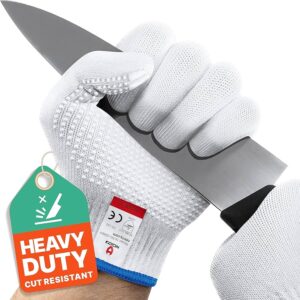
Cut-resistant work gloves are a type of personal protective equipment (PPE) designed to protect the wearer’s hands from cuts and lacerations. They are typically made from materials such as Kevlar, Dyneema, or stainless steel, which are resistant to sharp objects. Cut-resistant work gloves are used in a variety of industries, including manufacturing, construction, and food processing.
Cut-resistant work gloves are important because they can help to prevent serious injuries. Cuts and lacerations can be painful, debilitating, and even life-threatening. By wearing cut-resistant work gloves, workers can reduce their risk of these injuries.
In addition to their protective benefits, cut-resistant work gloves can also improve comfort and productivity. By protecting the hands from cuts and abrasions, cut-resistant work gloves can help to reduce fatigue and discomfort. This can lead to increased productivity and fewer errors.
1. Protection
Cut resistant work gloves are an essential piece of personal protective equipment (PPE) for workers in a variety of industries. They protect the wearer’s hands from cuts and lacerations, which can be serious and debilitating injuries. Cut resistant work gloves are made from a variety of materials, including Kevlar, Dyneema, and stainless steel, which are resistant to sharp objects.
The protection provided by cut resistant work gloves is essential for workers in a variety of industries, including manufacturing, construction, and food processing. In manufacturing, workers may be exposed to sharp objects such as knives, saws, and machinery. In construction, workers may be exposed to sharp objects such as nails, screws, and glass. In food processing, workers may be exposed to sharp objects such as knives and graters.
Without cut resistant work gloves, workers in these industries would be at a high risk of cuts and lacerations. These injuries can be painful, debilitating, and even life-threatening. In some cases, cuts and lacerations can lead to permanent disability. Cut resistant work gloves can help to prevent these injuries by providing a barrier between the wearer’s hands and sharp objects.
In addition to protecting the wearer’s hands from cuts and lacerations, cut resistant work gloves can also improve comfort and productivity. By protecting the hands from cuts and abrasions, cut resistant work gloves can help to reduce fatigue and discomfort. This can lead to increased productivity and fewer errors.
Cut resistant work gloves are an important part of a comprehensive safety program. By protecting the wearer’s hands from cuts and lacerations, cut resistant work gloves can help to prevent serious injuries and improve productivity.
2. Comfort
Cut resistant work gloves are designed to provide protection from cuts and lacerations, but they can also provide comfort and reduce fatigue. By protecting the hands from cuts and abrasions, cut resistant work gloves can help to reduce pain and discomfort. This can lead to increased productivity and fewer errors.
In addition, cut resistant work gloves can help to reduce fatigue by providing support and cushioning for the hands. This can be especially important for workers who perform repetitive tasks or who work in cold environments. Cut resistant work gloves can also help to absorb vibration, which can help to reduce fatigue and discomfort in the hands and arms.
The comfort provided by cut resistant work gloves is an important factor to consider when choosing a pair of gloves. Gloves that are comfortable to wear are more likely to be worn correctly and consistently, which can help to improve safety and productivity.
3. Productivity
Cut resistant work gloves can help to improve productivity by reducing the risk of injuries and errors. This is because cut resistant work gloves protect the wearer’s hands from cuts and lacerations, which can lead to pain, discomfort, and even lost time from work. In addition, cut resistant work gloves can help to reduce fatigue and improve dexterity, which can lead to increased productivity.
- Reduced risk of injuries and errors: Cut resistant work gloves can help to reduce the risk of injuries and errors by protecting the wearer’s hands from sharp objects. This can lead to increased productivity, as workers are less likely to be injured or make mistakes.
- Reduced pain and discomfort: Cut resistant work gloves can help to reduce pain and discomfort by protecting the wearer’s hands from cuts and abrasions. This can lead to increased productivity, as workers are more comfortable and less likely to be distracted by pain.
- Improved dexterity: Cut resistant work gloves can help to improve dexterity by providing a snug fit and allowing the wearer to move their fingers freely. This can lead to increased productivity, as workers are able to perform tasks more quickly and efficiently.
- Reduced fatigue: Cut resistant work gloves can help to reduce fatigue by providing support and cushioning for the hands. This can lead to increased productivity, as workers are less likely to be fatigued and more likely to be able to work for longer periods of time.
Overall, cut resistant work gloves can help to improve productivity by reducing the risk of injuries and errors, reducing pain and discomfort, improving dexterity, and reducing fatigue. This makes cut resistant work gloves an essential piece of personal protective equipment (PPE) for workers in a variety of industries.
4. Durability
Cut resistant work gloves are designed to be durable and withstand repeated use in demanding work environments. This durability is essential for ensuring that the gloves provide consistent protection against cuts and lacerations. The materials used in cut resistant work gloves, such as Kevlar, Dyneema, and stainless steel, are known for their strength and resistance to abrasion.
- Materials: Cut resistant work gloves are made from a variety of durable materials, including Kevlar, Dyneema, and stainless steel. These materials are resistant to cuts, abrasions, and punctures, which makes them ideal for use in demanding work environments.
- Construction: Cut resistant work gloves are constructed using a variety of techniques to ensure durability. These techniques include double stitching, reinforced seams, and padded palms. This construction helps to extend the life of the gloves and provides additional protection against cuts and lacerations.
- Testing: Cut resistant work gloves are tested to ensure that they meet industry standards for durability. These tests include cut resistance tests, abrasion resistance tests, and puncture resistance tests. By meeting these standards, cut resistant work gloves can be trusted to provide consistent protection against cuts and lacerations.
The durability of cut resistant work gloves is an important factor to consider when choosing a pair of gloves. Gloves that are durable will last longer and provide consistent protection, which can help to reduce the risk of injuries and improve productivity.
5. Variety
The variety of cut resistant work gloves available on the market is essential to ensuring that workers can find the right gloves for their specific needs. Different styles and sizes of gloves are available to accommodate different hand sizes, tasks, and work environments. This variety is important because it allows workers to find gloves that fit comfortably and provide the necessary protection.
-
Glove Style: Cut resistant work gloves are available in a variety of styles, including:
- Full-finger gloves: These gloves provide complete coverage for the hands and fingers, offering maximum protection.
- Half-finger gloves: These gloves provide coverage for the palm and fingers, but leave the fingertips exposed. This can provide greater dexterity for tasks that require fine motor skills.
- Fingerless gloves: These gloves cover the palm and wrist, but leave the fingers and thumb exposed. This can provide even greater dexterity for tasks that require a high degree of precision.
- Glove Size: Cut resistant work gloves are available in a variety of sizes to ensure a snug fit. A snug fit is important for maximizing protection and dexterity. Gloves that are too loose may slip off, while gloves that are too tight may restrict movement and cause discomfort.
-
Special Features: In addition to a variety of styles and sizes, cut resistant work gloves are also available with a variety of special features, such as:
- Cuffs: Gloves with cuffs provide added protection for the wrist and forearm.
- Reinforced fingertips: Gloves with reinforced fingertips provide extra protection for the fingertips, which are often the most vulnerable part of the hand.
- Anti-vibration padding: Gloves with anti-vibration padding can help to reduce fatigue and discomfort in the hands and arms.
By understanding the variety of cut resistant work gloves available, workers can choose the right gloves for their specific needs. This will help to ensure that they are adequately protected from cuts and lacerations, while still being able to perform their tasks comfortably and efficiently.
6. Compliance
Cut resistant work gloves play a crucial role in helping employers comply with safety regulations and protect their workers from hand injuries. Many industries have specific regulations regarding the use of cut resistant work gloves, and employers are responsible for ensuring that their employees have the appropriate PPE to perform their jobs safely.
For example, the Occupational Safety and Health Administration (OSHA) has regulations that require employers to provide their employees with personal protective equipment (PPE) to protect them from workplace hazards. This includes cut resistant work gloves for employees who are exposed to sharp objects or materials. By providing their employees with cut resistant work gloves, employers can help to reduce their risk of hand injuries and comply with OSHA regulations.
In addition to OSHA regulations, many other organizations and standards-setting bodies have developed guidelines for the use of cut resistant work gloves. These guidelines can help employers to select the appropriate gloves for their specific needs and ensure that their employees are adequately protected. By following these guidelines, employers can help to create a safer workplace and reduce their risk of liability.
Overall, cut resistant work gloves are an essential component of a comprehensive safety program. By providing their employees with cut resistant work gloves, employers can help to comply with safety regulations, reduce the risk of hand injuries, and create a safer workplace.
FAQs about Cut Resistant Work Gloves
Cut resistant work gloves are an essential piece of personal protective equipment (PPE) for workers in a variety of industries. They protect the wearer’s hands from cuts and lacerations, which can be serious and debilitating injuries. Here are some frequently asked questions about cut resistant work gloves:
Question 1: What are cut resistant work gloves?
Cut resistant work gloves are gloves that are made from materials that are resistant to cuts and lacerations. These materials include Kevlar, Dyneema, and stainless steel. Cut resistant work gloves are used in a variety of industries, including manufacturing, construction, and food processing.
Question 2: Why are cut resistant work gloves important?
Cut resistant work gloves are important because they can help to prevent serious injuries. Cuts and lacerations can be painful, debilitating, and even life-threatening. By wearing cut resistant work gloves, workers can reduce their risk of these injuries.
Question 3: What are the different types of cut resistant work gloves?
There are a variety of different types of cut resistant work gloves available. These gloves come in different styles, sizes, and materials. The type of glove that is best for a particular job will depend on the specific hazards that the worker is exposed to.
Question 4: How do I choose the right cut resistant work gloves?
When choosing cut resistant work gloves, it is important to consider the following factors: the type of work being performed, the hazards that the worker is exposed to, the dexterity required for the job, and the comfort of the gloves.
Question 5: How do I care for cut resistant work gloves?
Cut resistant work gloves should be inspected regularly for signs of damage. Gloves that are damaged should be replaced immediately. Gloves should be cleaned according to the manufacturer’s instructions.
Question 6: Where can I buy cut resistant work gloves?
Cut resistant work gloves can be purchased from a variety of sources, including safety supply stores, online retailers, and hardware stores.
Summary:
- Cut resistant work gloves are an essential piece of PPE for workers in a variety of industries.
- Cut resistant work gloves can help to prevent serious injuries, such as cuts and lacerations.
- There are a variety of different types of cut resistant work gloves available.
- When choosing cut resistant work gloves, it is important to consider the type of work being performed, the hazards that the worker is exposed to, the dexterity required for the job, and the comfort of the gloves.
- Cut resistant work gloves should be inspected regularly for signs of damage. Gloves that are damaged should be replaced immediately.
Transition to the next article section:
Now that you know more about cut resistant work gloves, you can make an informed decision about the best gloves for your needs. Be sure to choose gloves that are comfortable, durable, and provide the protection you need to stay safe on the job.
Tips for Using Cut Resistant Work Gloves
Cut resistant work gloves are an essential piece of personal protective equipment (PPE) for workers in a variety of industries. They protect the wearer’s hands from cuts and lacerations, which can be serious and debilitating injuries. By following these tips, you can ensure that your cut resistant work gloves provide the best possible protection and last as long as possible.
Tip 1: Choose the Right Gloves for the JobThe type of cut resistant work gloves you need will depend on the specific hazards you are exposed to. Consider the following factors when choosing gloves: The type of work being performed The materials being handled The sharpness of the objects being handled The frequency and duration of exposure to sharp objectsTip 2: Fit the Gloves ProperlyCut resistant work gloves should fit snugly but not too tightly. Gloves that are too loose may slip off, while gloves that are too tight may restrict movement and cause discomfort. To ensure a proper fit, measure your hand circumference and consult the manufacturer’s sizing chart.Tip 3: Inspect the Gloves RegularlyBefore each use, inspect your cut resistant work gloves for any signs of damage, such as cuts, tears, or punctures. Damaged gloves should be replaced immediately.Tip 4: Clean the Gloves RegularlyCut resistant work gloves should be cleaned regularly to remove dirt, debris, and sweat. Cleaning will help to extend the life of the gloves and prevent the growth of bacteria. To clean the gloves, follow the manufacturer’s instructions.Tip 5: Store the Gloves ProperlyWhen not in use, store your cut resistant work gloves in a cool, dry place away from direct sunlight. This will help to prevent the gloves from becoming damaged or.Tip 6: Replace the Gloves RegularlyEven with proper care, cut resistant work gloves will eventually need to be replaced. The frequency with which you need to replace your gloves will depend on the frequency and duration of use. As a general rule, gloves should be replaced every 6-12 months.
Summary:
- Choose the right gloves for the job.
- Fit the gloves properly.
- Inspect the gloves regularly.
- Clean the gloves regularly.
- Store the gloves properly.
- Replace the gloves regularly.
By following these tips, you can ensure that your cut resistant work gloves provide the best possible protection and last as long as possible.
Transition to the article’s conclusion:
Cut resistant work gloves are an essential piece of PPE for workers in a variety of industries. By following these tips, you can ensure that your gloves provide the best possible protection and last as long as possible. Remember to choose the right gloves for the job, fit the gloves properly, inspect the gloves regularly, clean the gloves regularly, store the gloves properly, and replace the gloves regularly.
Conclusion
Cut resistant work gloves are an essential piece of personal protective equipment (PPE) for workers in a variety of industries. They protect the wearer’s hands from cuts and lacerations, which can be serious and debilitating injuries. By understanding the importance of cut resistant work gloves and following the tips outlined in this article, you can ensure that you are adequately protected on the job.
Cut resistant work gloves are a relatively small investment that can have a big impact on your safety. By choosing the right gloves for the job, fitting them properly, and inspecting and cleaning them regularly, you can extend their lifespan and ensure that they provide the best possible protection. Remember, your hands are your most valuable tools, so protect them with cut resistant work gloves.



